|
|
|
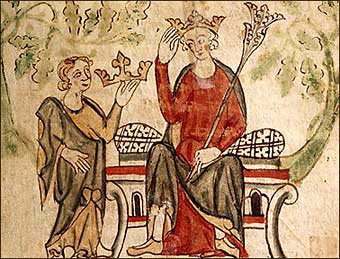

EDWARD II, "of Carnarvon," King of England, the fourth son of Edward I by his
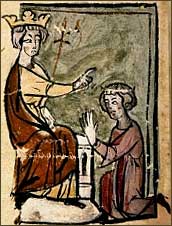 first wife Eleanor of Castile, was born at Carnarvon Castle on the 25th of April 1284. The story that the king presented
the new-born child to the Welsh as their future native prince is quite unfounded, for Edward was only made Prince of Wales
in the Lincoln parliament of 1301. When a few months old, he became by his elder brother's death the heir to the throne,
and Edward I took great pains to train him in warfare and statecraft. He took part in several Scots campaigns, but all
his father's efforts could not prevent his acquiring the habits of extravagance and frivolity which he retained all through
his life. The old king attributed his son's defects to the bad influence of his friend, the Gascon knight
Piers Gaveston, and drove the favourite into exile. When Edward I died, on the 7th of July 1307,
the first act of the prince, now Edward II, was to recall Gaveston. His next was to abandon the Scots campaign on which
his father had set his heart.
first wife Eleanor of Castile, was born at Carnarvon Castle on the 25th of April 1284. The story that the king presented
the new-born child to the Welsh as their future native prince is quite unfounded, for Edward was only made Prince of Wales
in the Lincoln parliament of 1301. When a few months old, he became by his elder brother's death the heir to the throne,
and Edward I took great pains to train him in warfare and statecraft. He took part in several Scots campaigns, but all
his father's efforts could not prevent his acquiring the habits of extravagance and frivolity which he retained all through
his life. The old king attributed his son's defects to the bad influence of his friend, the Gascon knight
Piers Gaveston, and drove the favourite into exile. When Edward I died, on the 7th of July 1307,
the first act of the prince, now Edward II, was to recall Gaveston. His next was to abandon the Scots campaign on which
his father had set his heart.
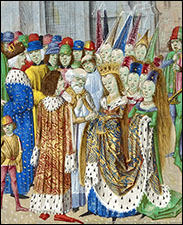 The new king was physically almost as fine a man as Edward I. He was, however, destitute of any serious purpose, and was,
as Dr Stubbs says, "the first king after the Conquest who was not a man of business." He cared for nothing but amusing
himself, and found his chief delight in athletics and in the practice of mechanical crafts. He was not so much vicious
as foolish, and wanting in all serious interests.
He had so little confidence in himself that he was always in the hands of some favourite who possessed a stronger will
than his own. In the early years of his reign Gaveston held this role, acting as regent when Edward went to France
— where, on the 25th of January 1308, he married Isabella, the daughter of Philip the Fair — and receiving
the earldom of Cornwall with the hand of the king's niece, Margaret of Gloucester.
The new king was physically almost as fine a man as Edward I. He was, however, destitute of any serious purpose, and was,
as Dr Stubbs says, "the first king after the Conquest who was not a man of business." He cared for nothing but amusing
himself, and found his chief delight in athletics and in the practice of mechanical crafts. He was not so much vicious
as foolish, and wanting in all serious interests.
He had so little confidence in himself that he was always in the hands of some favourite who possessed a stronger will
than his own. In the early years of his reign Gaveston held this role, acting as regent when Edward went to France
— where, on the 25th of January 1308, he married Isabella, the daughter of Philip the Fair — and receiving
the earldom of Cornwall with the hand of the king's niece, Margaret of Gloucester.
The barons soon grew indignant at Edward's devotion to his "brother Piers," and twice insisted on his banishment.
On each occasion Edward soon recalled his friend, whereupon the barons, headed by the king's cousin
Thomas, Earl of Lancaster, went to war against king and favourite, and in 1312
treacherously put Gaveston to death. Edward was not strong enough even to avenge his loss. He was forced to stand
aside and suffer the realm to be governed by the baronial committee of twenty-one Lords Ordainers, who, in 1311,
had drawn up a series of ordinances, whose effect was to substitute ordainers for the king as the effective government
of the country. But in all the ordinances nothing was said about the commons and lower clergy. Parliament meant to
the new rulers an assembly of barons just as it had done to the opponents of Henry III in 1258. The effect of their
triumph was to change England from a monarchy to a narrow oligarchy.
During the quarrels between Edward and the ordainers, Robert Bruce was steadily conquering Scotland. His progress
was so great that he had occupied all the fortresses save Stirling, which he closely besieged. The danger of losing
Stirling shamed Edward and the barons into an attempt to retrieve their lost ground. In June 1314 Edward led a great
army into Scotland in the hope of relieving Stirling. On the 24th of June his ill-disciplined and badly led host was
completely defeated by Robert Bruce at Bannockburn. Henceforth Bruce was sure of his position as king of Scots, and
his pitiless devastation of the northern counties of England was his wild vengeance for the sufferings his land had
previously experienced from the English.
Edward's disgraceful defeat made him more dependent on his barons than ever. His kinsman,
Thomas of Lancaster, had now an opportunity of saving England from the consequences
of the king's incompetence. He had shown some capacity as a leader of opposition, but though he had great wealth,
and was lord of five earldoms, he had small ability and no constructive power. In his desire to keep the king weak,
he was suspected to have made a secret understanding with Robert Bruce. Before long the opposition split up under
his incompetent guidance into fiercely contending factions. Under Aymer of Valence, Earl of Pembroke, a middle party
arose, which hated Lancaster so much that it supported the king to put an end to Lancaster's rule.
After 1318 the effect of its influence was to restore Edward to some portion of his authority. However, the king hated
Pembroke almost as much as Lancaster. He now found a competent adviser in Hugh le Despenser, a baron of great experience.
What was more important to him, he had in Despenser's son, Hugh le Despenser the younger, a personal friend and favourite,
who was able in some measure to replace Gaveston. The fierce hatred which the barons manifested to the Despensers showed
that they could hate a deserter as bitterly as they had hated the Gascon adventurer. They were indignant at the favours
which Edward lavished upon the favourite and his father, and were especially alarmed when the younger Despenser strove
to procure for himself the Earldom of Gloucester in right of his wife, Edward's niece.
At last, in 1321, the barons met in parliament, and under Lancaster's guidance procured the banishment of the
Despensers. The disasters of his friends inspired Edward to unwonted activity. In 1322 he recalled them from exile,
and waged war against the barons on their behalf. Triumph crowned his exertions. Lancaster, defeated at Boroughbridge,
was executed at Pontefract. For the next five years the Despensers ruled England. Unlike the ordainers, they took pains
to get the Commons on their side, and a parliament held at York in 1322 revoked the ordinances because they trenched
upon the rights of the crown, and were drawn up by the barons only. From this time no statute was technically valid
unless the Commons had agreed to it. This marks the most important step forward in Edward II's reign.
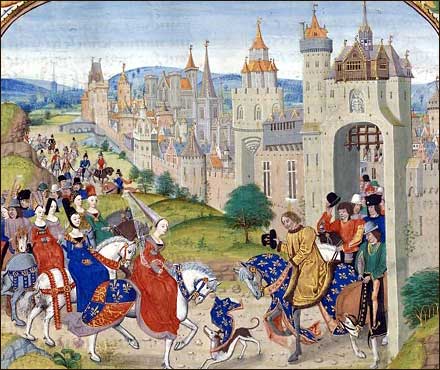
Queen Isabella being received by her brother, Charles le Bel, in France.
But the rule of the Despensers soon fell away from this wise beginning. They thought only of heaping up wealth for
themselves, and soon stirred up universal indignation. In particular, they excited the ill-will of the queen,
Isabella of France. Craftily dissembling her indignation, Isabella kept silence until 1325, when she went to France
in company with her eldest son, Edward of Windsor, who was sent to do homage for Aquitaine
to her brother, the new French king. When her business was over, Isabella declined to return to her husband as long as
the Despensers remained his favourites. She formed a criminal connexion with Roger Mortimer
of Wigmore, one of the baronial exiles, and in September 1326 landed in Essex accompanied by Mortimer and her son,
declaring that she was come to avenge the murder of Lancaster, and to expel the Despensers.
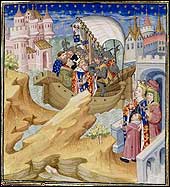
Edward's followers deserted him, and on the 2nd of October he fled from London to the west, where he took refuge in
the younger Despenser's estates in Glamorgan. His wife followed him, put to death both the Despensers, and, after a
futile effort to escape by sea, Edward was captured on the 16th of November. He was imprisoned at Kenilworth Castle, and
a parliament met at Westminster in January 1327, which chose his son to be king as Edward III.
It was thought prudent to compel the captive king to resign the crown, and on the 20th of January Edward was forced to
renounce his office before a committee of the estates.
The government of Isabella and Mortimer was so weakly established that it dared not leave the deposed king alive. On the
3rd of April he was secretly removed from Kenilworth and entrusted to the custody of two dependants of Mortimer. After
various wanderings he was imprisoned at Berkeley Castle in Gloucestershire. Every indignity was inflicted upon him, and
he was systematically ill-treated in the hope that he would die of disease. When his strong constitution seemed likely
to prevail over the ill-treatment of his enemies he was cruelly put to death on the 21st of September. It was announced
that he had died a natural death, and he was buried in St Peter's Abbey at Gloucester, now the cathedral, where his son
afterwards erected a magnificent tomb.
Edward's wife, Isabella (c.1292-1358), bore him two sons, Edward III and
John of Eltham, Earl of Cornwall (1316-1336), and two daughters, Isabella and Joanna (1321-1362),
wife of David II, King of Scotland.
(T. F. Tout)
Excerpted from:
Encyclopedia Britannica, 11th Ed. Vol VIII.
Cambridge: Cambridge University Press, 1910. 994.
Other Local Resources:
External Resources:
Books for further study:
Doherty, Paul. Isabella and the Strange Death of Edward II.
Carroll & Graf, 2003.
Fryde, Natalie. The Tyranny and Fall of Edward II 1321-1326.
Cambridge University Press, 2003.
Haines, R. M. King Edward II: His Life, His Reign, and Its Aftermath.
McGill-Queen's University Press, 2006.
Marlowe, Christopher. Edward the Second.
Adamant Media Corporation, 2001.
Phillips, Seymour. Edward II.
Yale University Press, 2012.
Warner, Kathryn. Edward II: The Unconventional King.
Amberley Publishing, 2014.
 | to King Edward III |
 | to Luminarium Encyclopedia |
Site ©1996-2023 Anniina Jokinen. All rights reserved.
This page was created on April 27, 2007. Last updated March 25, 2023.
|
Index of Encyclopedia Entries:
Medieval Cosmology
Prices of Items in Medieval England
Edward II
Isabella of France, Queen of England
Piers Gaveston
Thomas of Brotherton, E. of Norfolk
Edmund of Woodstock, E. of Kent
Thomas, Earl of Lancaster
Henry of Lancaster, Earl of Lancaster
Henry of Grosmont, Duke of Lancaster
Roger Mortimer, Earl of March
Hugh le Despenser the Younger
Bartholomew, Lord Burghersh, elder
Hundred Years' War (1337-1453)
Edward III
Philippa of Hainault, Queen of England
Edward, Black Prince of Wales
John of Eltham, Earl of Cornwall
The Battle of Crécy, 1346
The Siege of Calais, 1346-7
The Battle of Poitiers, 1356
Lionel of Antwerp, Duke of Clarence
John of Gaunt, Duke of Lancaster
Edmund of Langley, Duke of York
Thomas of Woodstock, Gloucester
Richard of York, E. of Cambridge
Richard Fitzalan, 3. Earl of Arundel
Roger Mortimer, 2nd Earl of March
The Good Parliament, 1376
Richard II
The Peasants' Revolt, 1381
Lords Appellant, 1388
Richard Fitzalan, 4. Earl of Arundel
Archbishop Thomas Arundel
Thomas de Beauchamp, E. Warwick
Robert de Vere, Earl of Oxford
Ralph Neville, E. of Westmorland
Thomas Mowbray, Duke of Norfolk
Edmund Mortimer, 3. Earl of March
Roger Mortimer, 4. Earl of March
John Holland, Duke of Exeter
Michael de la Pole, E. Suffolk
Hugh de Stafford, 2. E. Stafford
Henry IV
Edward, Duke of York
Edmund Mortimer, 5. Earl of March
Henry Percy, Earl of Northumberland
Sir Henry Percy, "Harry Hotspur"
Thomas Percy, Earl of Worcester
Owen Glendower
The Battle of Shrewsbury, 1403
Archbishop Richard Scrope
Thomas Mowbray, 3. E. Nottingham
John Mowbray, 2. Duke of Norfolk
Thomas Fitzalan, 5. Earl of Arundel
Henry V
Thomas, Duke of Clarence
John, Duke of Bedford
Humphrey, Duke of Gloucester
John Talbot, Earl of Shrewsbury
Richard, Earl of Cambridge
Henry, Baron Scrope of Masham
William de la Pole, Duke of Suffolk
Thomas Montacute, E. Salisbury
Richard Beauchamp, E. of Warwick
Henry Beauchamp, Duke of Warwick
Thomas Beaufort, Duke of Exeter
Cardinal Henry Beaufort
John Beaufort, Earl of Somerset
Sir John Fastolf
John Holland, 2. Duke of Exeter
Archbishop John Stafford
Archbishop John Kemp
Catherine of Valois
Owen Tudor
John Fitzalan, 7. Earl of Arundel
John, Lord Tiptoft
Charles VII, King of France
Joan of Arc
Louis XI, King of France
Charles the Bold, Duke of Burgundy
The Battle of Agincourt, 1415
The Battle of Castillon, 1453
The Wars of the Roses 1455-1485
Causes of the Wars of the Roses
The House of Lancaster
The House of York
The House of Beaufort
The House of Neville
The First Battle of St. Albans, 1455
The Battle of Blore Heath, 1459
The Rout of Ludford, 1459
The Battle of Northampton, 1460
The Battle of Wakefield, 1460
The Battle of Mortimer's Cross, 1461
The 2nd Battle of St. Albans, 1461
The Battle of Towton, 1461
The Battle of Hedgeley Moor, 1464
The Battle of Hexham, 1464
The Battle of Edgecote, 1469
The Battle of Losecoat Field, 1470
The Battle of Barnet, 1471
The Battle of Tewkesbury, 1471
The Treaty of Pecquigny, 1475
The Battle of Bosworth Field, 1485
The Battle of Stoke Field, 1487
Henry VI
Margaret of Anjou
Richard Plantagenet, Duke of York
Edward IV
Elizabeth Woodville
Richard Woodville, 1. Earl Rivers
Anthony Woodville, 2. Earl Rivers
Jane Shore
Edward V
Richard III
George, Duke of Clarence
Ralph Neville, 2. Earl of Westmorland
Richard Neville, Earl of Salisbury
Richard Neville, Earl of Warwick
Edward Neville, Baron Bergavenny
William Neville, Lord Fauconberg
Robert Neville, Bishop of Salisbury
John Neville, Marquis of Montagu
George Neville, Archbishop of York
John Beaufort, 1. Duke Somerset
Edmund Beaufort, 2. Duke Somerset
Henry Beaufort, 3. Duke of Somerset
Edmund Beaufort, 4. Duke Somerset
Margaret Beaufort
Edmund Tudor, Earl of Richmond
Jasper Tudor, Earl of Pembroke
Humphrey Stafford, D. Buckingham
Henry Stafford, Duke of Buckingham
Humphrey Stafford, E. of Devon
Thomas, Lord Stanley, Earl of Derby
Sir William Stanley
Archbishop Thomas Bourchier
Henry Bourchier, Earl of Essex
John Mowbray, 3. Duke of Norfolk
John Mowbray, 4. Duke of Norfolk
John Howard, Duke of Norfolk
Henry Percy, 2. E. Northumberland
Henry Percy, 3. E. Northumberland
Henry Percy, 4. E. Northumberland
William, Lord Hastings
Henry Holland, Duke of Exeter
William Fitzalan, Earl of Arundel
William Herbert, 1. Earl of Pembroke
John de Vere, 12th Earl of Oxford
John de Vere, 13th Earl of Oxford
Thomas de Clifford, 8. Baron Clifford
John de Clifford, 9. Baron Clifford
John Tiptoft, Earl of Worcester
Thomas Grey, 1. Marquis Dorset
Sir Andrew Trollop
Archbishop John Morton
Edward Plantagenet, E. of Warwick
John Talbot, 2. E. Shrewsbury
John Talbot, 3. E. Shrewsbury
John de la Pole, 2. Duke of Suffolk
John de la Pole, E. of Lincoln
Edmund de la Pole, E. of Suffolk
Richard de la Pole
John Sutton, Baron Dudley
James Butler, 5. Earl of Ormonde
Sir James Tyrell
Edmund Grey, first Earl of Kent
George Grey, 2nd Earl of Kent
John, 5th Baron Scrope of Bolton
James Touchet, 7th Baron Audley
Walter Blount, Lord Mountjoy
Robert Hungerford, Lord Moleyns
Thomas, Lord Scales
John, Lord Lovel and Holand
Francis Lovell, Viscount Lovell
Sir Richard Ratcliffe
William Catesby
Ralph, 4th Lord Cromwell
Jack Cade's Rebellion, 1450
Tudor Period
King Henry VII
Queen Elizabeth of York
Arthur, Prince of Wales
Lambert Simnel
Perkin Warbeck
The Battle of Blackheath, 1497
King Ferdinand II of Aragon
Queen Isabella of Castile
Maximilian I, Holy Roman Emperor
King Henry VIII
Queen Catherine of Aragon
Queen Anne Boleyn
Queen Jane Seymour
Queen Anne of Cleves
Queen Catherine Howard
Queen Katherine Parr
King Edward VI
Queen Mary I
Queen Elizabeth I
Henry Fitzroy, Duke of Richmond
Margaret Tudor, Queen of Scotland
James IV, King of Scotland
The Battle of Flodden Field, 1513
James V, King of Scotland
Mary of Guise, Queen of Scotland
Mary Tudor, Queen of France
Louis XII, King of France
Francis I, King of France
The Battle of the Spurs, 1513
Field of the Cloth of Gold, 1520
Charles V, Holy Roman Emperor
Eustace Chapuys, Imperial Ambassador
The Siege of Boulogne, 1544
Cardinal Thomas Wolsey
Archbishop Thomas Cranmer
Thomas Cromwell, Earl of Essex
Thomas, Lord Audley
Thomas Wriothesley, E. Southampton
Sir Richard Rich
Edward Stafford, D. of Buckingham
Thomas Howard, 2nd Duke of Norfolk
Thomas Howard, 3rd Duke of Norfolk
John Dudley, Duke of Northumberland
Charles Brandon, Duke of Suffolk
Thomas Boleyn, Earl of Wiltshire
George Boleyn, Viscount Rochford
John Russell, Earl of Bedford
Thomas Grey, 2. Marquis of Dorset
Henry Grey, D. of Suffolk
Charles Somerset, Earl of Worcester
George Talbot, 4. E. Shrewsbury
Francis Talbot, 5. E. Shrewsbury
Henry Algernon Percy,
5th Earl of Northumberland
Henry Algernon Percy,
6th Earl of Northumberland
Ralph Neville, 4. E. Westmorland
Henry Neville, 5. E. Westmorland
William Paulet, Marquis of Winchester
Sir Francis Bryan
Sir Nicholas Carew
John de Vere, 15th Earl of Oxford
John de Vere, 16th Earl of Oxford
Thomas Seymour, Lord Admiral
Edward Seymour, Protector Somerset
Margaret Pole, Countess of Salisbury
Henry Pole, Lord Montague
Sir Geoffrey Pole
Thomas Manners, Earl of Rutland
Henry Manners, Earl of Rutland
Henry Bourchier, 2. Earl of Essex
Robert Radcliffe, 1. Earl of Sussex
Henry Radcliffe, 2. Earl of Sussex
George Hastings, Earl of Huntingdon
Henry Courtenay, Marquis of Exeter
George Neville, Baron Bergavenny
Sir Edward Neville
William, Lord Paget
William Sandys, Baron Sandys
William Fitzwilliam, E. Southampton
Sir Anthony Browne
Sir Thomas Wriothesley
Sir William Kingston
George Brooke, Lord Cobham
Sir Richard Southwell
Thomas Fiennes, 9th Lord Dacre
Sir Francis Weston
Henry Norris
Lady Jane Grey
Sir Thomas Arundel
Sir Richard Sackville
Sir William Petre
Sir John Cheke
Walter Haddon, L.L.D
Sir Peter Carew
Sir John Mason
Nicholas Wotton
John Taylor
Sir Thomas Wyatt, the Younger
Cardinal Lorenzo Campeggio
Cardinal Reginald Pole
Stephen Gardiner, Bishop of Winchester
Edmund Bonner, Bishop of London
Nicholas Ridley, Bishop of London
John Hooper, Bishop of Gloucester
John Aylmer, Bishop of London
Thomas Linacre
William Grocyn
Archbishop William Warham
Cuthbert Tunstall, Bishop of Durham
Richard Fox, Bishop of Winchester
Edward Fox, Bishop of Hereford
Pope Julius II
Pope Leo X
Pope Clement VII
Pope Paul III
Pope Pius V
Pico della Mirandola
Desiderius Erasmus
Martin Bucer
Richard Pace
Christopher Saint-German
Thomas Tallis
Elizabeth Barton, the Nun of Kent
Hans Holbein, the Younger
The Sweating Sickness
Dissolution of the Monasteries
Pilgrimage of Grace, 1536
Robert Aske
Anne Askew
Lord Thomas Darcy
Sir Robert Constable
Oath of Supremacy
The Act of Supremacy, 1534
The First Act of Succession, 1534
The Third Act of Succession, 1544
The Ten Articles, 1536
The Six Articles, 1539
The Second Statute of Repeal, 1555
The Act of Supremacy, 1559
Articles Touching Preachers, 1583
Queen Elizabeth I
William Cecil, Lord Burghley
Robert Cecil, 1st Earl of Salisbury
Sir Francis Walsingham
Sir Nicholas Bacon
Sir Thomas Bromley
Robert Dudley, Earl of Leicester
Ambrose Dudley, Earl of Warwick
Henry Carey, Lord Hunsdon
Sir Thomas Egerton, Viscount Brackley
Sir Francis Knollys
Katherine "Kat" Ashley
Lettice Knollys, Countess of Leicester
George Talbot, 6. E. of Shrewsbury
Elizabeth, Countess of Shrewsbury
Gilbert Talbot, 7. E. of Shrewsbury
Sir Henry Sidney
Sir Robert Sidney
Archbishop Matthew Parker
Walter Devereux, 1st Earl of Essex
Robert Devereux, 2nd Earl of Essex
Penelope Devereux, Lady Rich
Sir Christopher Hatton
Edward Courtenay, E. Devonshire
Edward Manners, 3rd Earl of Rutland
Thomas Radcliffe, 3. Earl of Sussex
Henry Radcliffe, 4. Earl of Sussex
Robert Radcliffe, 5. Earl of Sussex
William Parr, Marquis of Northampton
Henry Wriothesley, 2. Southampton
Henry Wriothesley, 3. Southampton
Charles Neville, 6. E. Westmorland
Thomas Percy, 7. E. Northumberland
Henry Percy, 8. E. Northumberland
Henry Percy, 9. E. Nothumberland
William Herbert, 1. Earl of Pembroke
Charles, Lord Howard of Effingham
Thomas Howard, 4th Duke of Norfolk
Henry Howard, 1. Earl of Northampton
Thomas Howard, 1. Earl of Suffolk
Henry Hastings, 3. E. of Huntingdon
Edward Manners, 3rd Earl of Rutland
Roger Manners, 5th Earl of Rutland
Francis Manners, 6th Earl of Rutland
Henry FitzAlan, 12. Earl of Arundel
Thomas, Earl Arundell of Wardour
Edward Somerset, E. of Worcester
William Davison
Sir Walter Mildmay
Sir Ralph Sadler
Sir Amyas Paulet
Gilbert Gifford
Anthony Browne, Viscount Montague
François, Duke of Alençon & Anjou
Mary, Queen of Scots
Henry Stuart, Lord Darnley
James Hepburn, Earl of Bothwell
Anthony Babington and the Babington Plot
John Knox
Philip II of Spain
The Spanish Armada, 1588
Sir Francis Drake
Sir John Hawkins
William Camden
Archbishop Whitgift
Martin Marprelate Controversy
John Penry (Martin Marprelate)
Richard Bancroft, Archbishop of Canterbury
John Dee, Alchemist
Philip Henslowe
Edward Alleyn
The Blackfriars Theatre
The Fortune Theatre
The Rose Theatre
The Swan Theatre
Children's Companies
The Admiral's Men
The Lord Chamberlain's Men
Citizen Comedy
The Isle of Dogs, 1597
Common Law
Court of Common Pleas
Court of King's Bench
Court of Star Chamber
Council of the North
Fleet Prison
Assize
Attainder
First Fruits & Tenths
Livery and Maintenance
Oyer and terminer
Praemunire
The Stuarts
King James I of England
Anne of Denmark
Henry, Prince of Wales
The Gunpowder Plot, 1605
George Villiers, 1st Duke of Buckingham
Robert Carr, Earl of Somerset
Arabella Stuart, Lady Lennox
William Alabaster
Bishop Hall
Bishop Thomas Morton
Archbishop William Laud
John Selden
Lucy Harington, Countess of Bedford
Henry Lawes
King Charles I
Queen Henrietta Maria
Long Parliament
Rump Parliament
Kentish Petition, 1642
Thomas Wentworth, Earl of Strafford
John Digby, Earl of Bristol
George Digby, 2nd Earl of Bristol
Thomas Fairfax, 3rd Lord Fairfax
Robert Devereux, 3rd E. of Essex
Robert Sidney, 2. E. of Leicester
Algernon Percy, E. of Northumberland
Henry Montagu, Earl of Manchester
Edward Montagu, 2. Earl of Manchester
The Restoration
King Charles II
King James II
Test Acts
Greenwich Palace
Hatfield House
Richmond Palace
Windsor Palace
Woodstock Manor
The Cinque Ports
Mermaid Tavern
Malmsey Wine
Great Fire of London, 1666
Merchant Taylors' School
Westminster School
The Sanctuary at Westminster
"Sanctuary"
Images:
Chart of the English Succession from William I through Henry VII
Medieval English Drama
London c1480, MS Royal 16
London, 1510, the earliest view in print
Map of England from Saxton's Descriptio Angliae, 1579
London in late 16th century
Location Map of Elizabethan London
Plan of the Bankside, Southwark, in Shakespeare's time
Detail of Norden's Map of the Bankside, 1593
Bull and Bear Baiting Rings from the Agas Map (1569-1590, pub. 1631)
Sketch of the Swan Theatre, c. 1596
Westminster in the Seventeenth Century, by Hollar
Visscher's View of London, 1616
Larger Visscher's View in Sections
c. 1690. View of London Churches, after the Great Fire
The Yard of the Tabard Inn from Thornbury, Old and New London
|
|